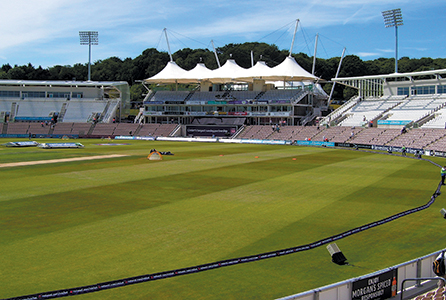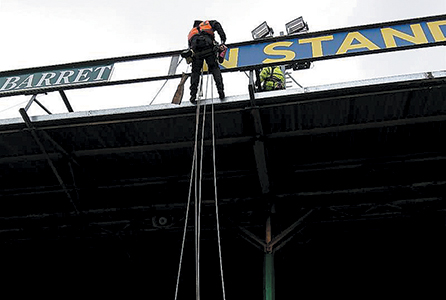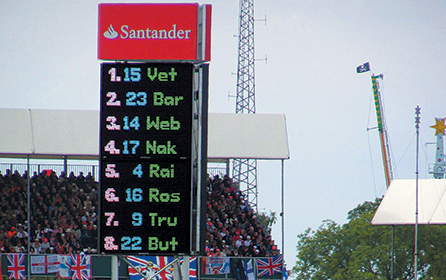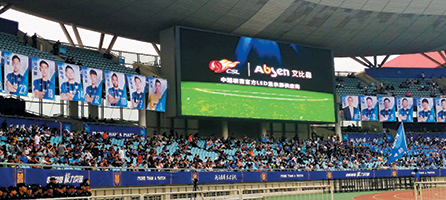
Daktronics are a global sports signage producer and supplier and have worked with the LA Angels
Digital vs traditional
If you are a regular reader of SignLink, you will have seen my feature on how to find and bid for major sporting signage contracts. This discussion continues, as I debate the pros and cons of digital and traditional signage within sport.
The experience of fans at major events, whether that be a sports match, concert or festival, is of the utmost importance to organisers. Sporting competitions, in particular, rely on signage for advertising purposes, as well as keeping score and showing replays. Digital screens can even be a major factor for referees to make a decision, something we see in both cricket and rugby. These screens provide referees, umpires and indeed fans, with a video replay to reach a decision.
Using the English Football League as an example, in the lower leagues such as League One and Two, they tend to have printed signage rather than digital advertising boards. As a Yeovil Town fan, one is used to more traditional signage at Huish Park, Yeovil’s home ground. When a digital screen to display the score was installed, it was almost a shock. It may be a very small digital screen that could only rival a digital ‘open’ sign in a shop, but it was still a switch for the lower league side.
When Manchester United were lucky enough to draw Yeovil Town in the FA fourth round away at Huish Park, the changes made to the signage were astronomical for a smaller side. Digital boards were installed as the game would be broadcast live on the BBC. Does this mean that football clubs and broadcasting stations feel that digital signage benefits fans and viewers more? Or most likely, was it purely for advertising purposes?
One sporting organisation, Hampshire Cricket Club, forged a partnership with Samsung and Evolve AV and has installed digital signage, which it believes, will enhance the participation with fans and improve their experience. The installation of digital signage was also a bid to become more appealing to the English and Wales Cricket Board (ECB) to be an international ground for England matches more often.
Two full-HD 1080p screens from Samsung have been installed over a few months and finished in April of this year, totalling 120sq m (1291sq ft) of digital signage. The move allowed the cricket ground to become the first Samsung fully connected stadium in the UK, with over 200 connectivity points created. All of this was to enhance fan engagement and present advertising opportunities.

The Ageas Bowl, home to Hampshire Cricket Club, had two full-HD 1080p screens from Samsung installed to enhance fan experience on match days
There are different formats of the game in cricket, one of which is the T20 Blast campaign, an edition of the game that is very fan-central. Digital signage in this instance is vital to provide an atmosphere for those watching.
At the time, David Mann, chief executive officer for the Ageas Bowl, said: “The Ageas Bowl has a track record of innovation, and this partnership with two industry-leading organisations will enable us to lead the way in the development and use of new technology and will have a hugely positive impact on the match day experience.”
Not only are the screens a part of the digital revolution, but also the connectivity within the stadium, with Wi-Fi also incorporated into the fan experience. Ben Holmes, head of display at Samsung UK, says: “Samsung is delighted to partner with The Ageas Bowl to transform this site of sporting history to a world-class connected stadium, designed to create a welcoming environment for cricket fans and sports enthusiasts.”
O Factoid: The first bowler to take four wickets in four balls in a first-class cricket match was Joseph Wells, father of the author HG Wells, in 1862. O
Arguably, in sports such as cricket where the entertainment on the wicket can be slower than that of a football or rugby game, digital signage, screens and Wi-Fi are key to enticing fans in, particularly younger fans who need something to grab their attention at all times.
For Signs Express Grantham, which has an ongoing relationship with Premiership rugby union club Leicester Tigers, traditional signage can also provide an experience for fans, clubs and sponsorship. Recently, the Grantham branch had a week to transform the Crumbie stand to the Breedon Stand, and the Cube building inside the Welford Road stadium before the East Midlands derby clash with Northampton Saints earlier in the year. In this situation, the RFU club wanted to maintain the history of the stand, which included keeping with traditional printed signage. Around 300m of aluminium boards were fitted by Signs Express Grantham in the stand, in front of the seating area and on the roof.

Signs Express Grantham had one week to rebrand the Crumbie stand at Leicester Tigers, demonstrating the flexibility necessary to work in sports
Tigers’ commercial director Andrea Pinchen argues that keeping the signage in a traditional format is key to a fan’s experience because of the history and traditions. She says: “For all associated with the club, the Breedon Stand represents the strong history, heritage and success of this club. Throughout the stadium’s redevelopment in recent years, the traditions of the stand have remained – something the players and fans are keen to uphold.”
Ian Charles, director of Signs Express Grantham, agrees that traditional printed signage at a sports club is key to a fan’s experience. The consistency of the message is also important for sponsors and fans that want to uphold the legacy and history of their team. Charles adds that digital signage adds something else: “To me, they’re totally different in what they offer. Digital signage can be changed and adapted at a second’s notice and portray a rolling message, whereas more traditional printed signs can give a consistent brand and message over a long period of time.
“Some of the partners they have at Leicester will be there for three to five years, so they want something that’s going to be fairly consistent that is going to be in the eye of the supporter the whole season. I think, for me, that’s the main difference. If they want to change something very quickly and have a quick turnover then they will probably go for something more digital, but if they’re happy with something that is going to be more consistent and give the fan an ongoing message throughout the whole season then the signage is going to be printed.”
Brent Stevens, national sales manager for professional sports for American company Daktronics, says that digital is actually the way forward for sports signage, for both advertising and enhancing the experience for fans. He explains: “When talking about the experience for the fans, it makes everything more exciting when you go digital.

When talking about the experience for the fans, it makes everything more exciting when you go digital”
For example, when a player hits a homerun (in baseball) you have a beverage advertisement in the outfield, and in that special moment of the game, you still have a beverage advertisement to a full-motion ‘Homerun’ animation yet still show that same beverage advertisement below the animation or to the side of the animation.”
Stevens continues: “You can manipulate a digital canvas with dynamic content, and that motion catches people’s attention and creates an exciting atmosphere around any special game-day moment. Even if it’s an advertisement.
You can work with the advertiser to make their piece do what they need it to do, and it just makes for a better experience.”
Daktronics has supplied digital signage to the biggest stadiums and clubs all over the world, breaking world records with its 360-degree halo board at the Mercedes-Benz Stadium in Atlanta, to providing scoreboards for universities. Daktronics has also installed digital signage in motorsports, most noticeably for the 2009 British Formula One Grad Prix, where the manufacturer had to install the sign within a matter of hours. It was a scoreboard, which is important to update fans of the position of each driver. In a sport such as F1 where cars are all over the track and often not in front of the crowd, digital signage and screens are the only way to watch the action. Digital screens in the sport are imperative for the engagement of fans.

Formula 1 is a sport where fans rely on screens to be able to follow the action around the race track when watching live at the track
Another manufacturer that is no stranger to having an input in digital signage around the globe is Absen. The company has a partnership with the Chinese Super League, a sporting league that is growing extensively and enticing well-known footballers to play in China. Absen has also provided signage for the FIFA World Cup in Russia in the summer, as well as Atletico Madrid and Chelsea Football Club. The company was formed in 2001 and is present in 120 countries with over 1,200 employees and headquarters in Shenzhen, China and a European base in Frankfurt, Germany.

Absen hold the contract for digital signage with the Chinese Super League until the 2020 season
Ross Burling, business development manager UK, Ireland and Nordics for Absen Europe, says that the question of digital signage versus more traditional signage is more complex than one might first think. He explains that when talking about digital versus traditional signage, “It is important to understand which area of digital signage in the stadium we are talking about – big screens and scoreboards, centre-hung displays (typically found in the US rather than in Europe), pitch-side perimeter or first or second fascia boards?
“Each area serves a different purpose. For example, the big screen displays are for the benefit of the fans in the stadium showing information such as video replays, scores, statistics and advertising, whereas the pitch-side perimeter boards are targeted at the broadcaster for the benefit of the TV viewer and the associated advertising revenues from broadcast TV.”
However, Burling comments that digital signage can offer a little more than traditional signage, stating: “Generally speaking, digital signage has the following benefits compared to printed signage; they are bright, colourful, moving images which can be further enhanced when linked to the stadium audio and also creates a real time interactive experience for the fans and customers.

Ross Burling, business development manager UK, Ireland and Nordics for Absen Europe
“Instant information such as replays, and related advertising content can be displayed in real time within seconds. There is a proven ROI (return on investment) model for brands and advertisers both in the stadium and in many cases live on TV. Digital also provides flexibility to react to events in the stadium and change any or all of the advertising messages accordingly. Once installed, other than power requirements, there is virtually no further cost for labour to change or replace static displays when they need updating for a change of advertiser or the printing of any new signage.”
Burling goes on to discuss further benefits for fans, he adds: “The big screen displays allow the fan to experience real time replays of the action in stadium, but also from matches at other stadiums, normally during the interval or at half time. They also provide real time statistics such as scores, player info, playing time, yellow and red cards etc.

The big screen displays allow the fan to experience real time replays of the action in stadium”
“Advertisers and brands can also offer enticements to fans to get them to make purchases with special offers on concessions such as food and drink and also special events or competitions to win prizes during the game. A lot of this interaction takes place via mobile phones on apps operated by the stadium or by local phone company providers.”
Most importantly however, he says, is the addition to the atmosphere that digital signage can bring. Burling concludes: “Quite often clubs will run 30 minutes of pre-match build up with highlights from previous wins and matches, as well as associated music and advertising clips.”
It seems that in an increasingly technical world that digital signage has trumped traditional printed signage in sporting leagues and mega events. While print and traditional signage still play a crucial part in advertising as do wayfinding signage at stadia and Olympic parks, digital is the way to engage fans and create a more impressive atmosphere.
Your text here...